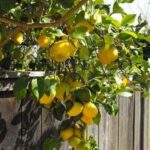While the fruit of citrus trees is most welcome at all times that of the lemon is particularly welcome during warm weather when cool drinks are in great demand. However, it isn’t the healthfulness nor the tastiness of the fruit, but the overall beauty of the tree that has made them so popular.
We might add that their easy maintenance also may have some bearing on their great popularity. I fertilize my lemon tree twice a year, once in early spring and again in early October, and I have lemons on my tree the year around. In fact the Eureka variety of lemon is noted for having fruit and bloom the year around when they are given the proper care. When I moved into my former home there was a rangy Eureka lemon tree at the South end of one of the terraces. The gardener recommended that I take it out because it was unproductive. I shaped up the top and fertilized it generously. The next year it began to bear and from then on I had lemons to share.
Fertilizing is important. I used a commercial fertilizer especially blended for citrus. A soil augur was used to drill holes at 18-inch intervals around the drip lile of the tree. These holes were made approximately one foot deep and the amount of fertilizer recommended on the label for a tree of that caliber was divided among the holes. The holes then were filled to the top with soil and the whole area watered thoroughly.
Watering is very important. The best tip growth takes place when the soil is warm and moist. Watch your tree for signs of moisture needs. When the leaves begin to wilt and curl slightly the roots are signaling their need for more moisture. Planted out in the garden, citrus trees need water during the hot summer months about every two weeks. In containers, the size of the tree determines the frequency of watering. Usually every other day is enough but if it is windy I find they need water every day. Here again watch the leaves.
In containers citrus need fertilizing much more frequently than they do in the open garden. The reason is quite clear. Container grown plants must be watered so frequently that the nutrients are washed (leached) out of the soil at much shorter intervals. Light applications once every week keep the trees in tip-top shape. A slow-release fertilizer or a controlled release fertilizer can be used to stretch the periods between applications.
Like all evergreens, from pines to roses, citrus are subject to infestations of pest. Most frequently found are aphis, red spider, thrip and scale. Hosing the plants down frequently during hot weather usually keeps the red spider under control. I have been most successful in keeping my plants trouble free by spraying in May and again in August with a final spray in late October. I use malathion with a good sticker spreader. If ants or earwigs are a problem I spray (when I see the ants or damage from earwigs) with a 10 percent solution of chlordane. In using chlordane for these two pests be sure to cover the soil for some distance around the tree.
Eureka Lemon
http://www.australiancitrusgrowers.com/aspdev/resources/documents/Eureka9-02.pdf




